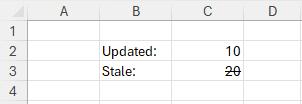Stale Value Formatting
9 August 2023
Microsoft has just announced a significant improvement to one of spreadsheeting's oldest features: Manual calculation mode. 44 years ago, Manual calculation mode debuted in VisiCalc in 1979, six [6] years before the first release of Excel. Since its release, the user experience has remained largely the same, until now…
Manual calculation mode suspends calculations, which means that the values in cells can become out of date. Microsoft refers to these as being stale. When you edit a cell in a spreadsheet, not all cells become stale, just the ones that depend on your change. Excel tracks stale cells internally. Unfortunately, there has been no way to see which cells were pending calculation.
However, with this update, Excel can show these
stale cells by striking them out. That way, you know not to rely on them until
they are calculated.

Whilst stale formatting will most often be seen in Manual calculation mode, it is not limited to it. For example, you may get stale cells in Automatic calculation mode if you abort a long-running calculation by pressing ESC. Once the calculation resumes and completes, the stale formatting will be lifted.
When a cell containing a stale value is selected, Excel will show a warning icon. If you click on the icon, you will be provided with a menu with contextual actions, such as triggering calculation or switching to Automatic calculation mode.

‘Stale Value Formatting’ is an application setting that is on by default. If you prefer, you can turn it off via the ‘Format Stale Values’ checkbox located under the ‘Calculation Options’ menu on the Formulas tab.

Stale Formatting is currently available to users running Beta Channel on Windows. This feature will roll out to Excel for Windows first and come to the other platforms at a later date.

